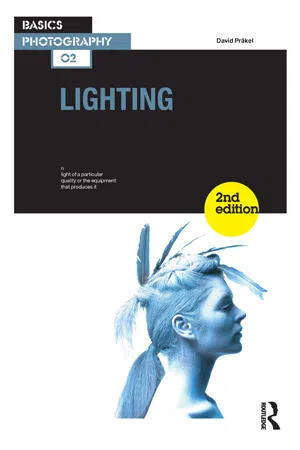
eBook - ePub
Lighting
David Präkel
This is a test
- 192 pages
- English
- ePUB (mobile friendly)
- Available on iOS & Android
eBook - ePub
Lighting
David Präkel
Book details
Book preview
Table of contents
Citations
About This Book
Understanding light is fundamental to good photography. How any image is lit will change how the viewer sees and interprets the content. The second edition of Lighting teaches the theory and background of how light works, the different types of light and the rules it obeys. The book gives guidance on how to measure, control and use light for the best photographic exposure. With new images and case studies, this edition encourages a bolder and more innovative approach to the use of light in photography.
Frequently asked questions
At the moment all of our mobile-responsive ePub books are available to download via the app. Most of our PDFs are also available to download and we're working on making the final remaining ones downloadable now. Learn more here.
Both plans give you full access to the library and all of Perlego’s features. The only differences are the price and subscription period: With the annual plan you’ll save around 30% compared to 12 months on the monthly plan.
We are an online textbook subscription service, where you can get access to an entire online library for less than the price of a single book per month. With over 1 million books across 1000+ topics, we’ve got you covered! Learn more here.
Look out for the read-aloud symbol on your next book to see if you can listen to it. The read-aloud tool reads text aloud for you, highlighting the text as it is being read. You can pause it, speed it up and slow it down. Learn more here.
Yes, you can access Lighting by David Präkel in PDF and/or ePUB format, as well as other popular books in Art & Photography. We have over one million books available in our catalogue for you to explore.
Information
What is light?
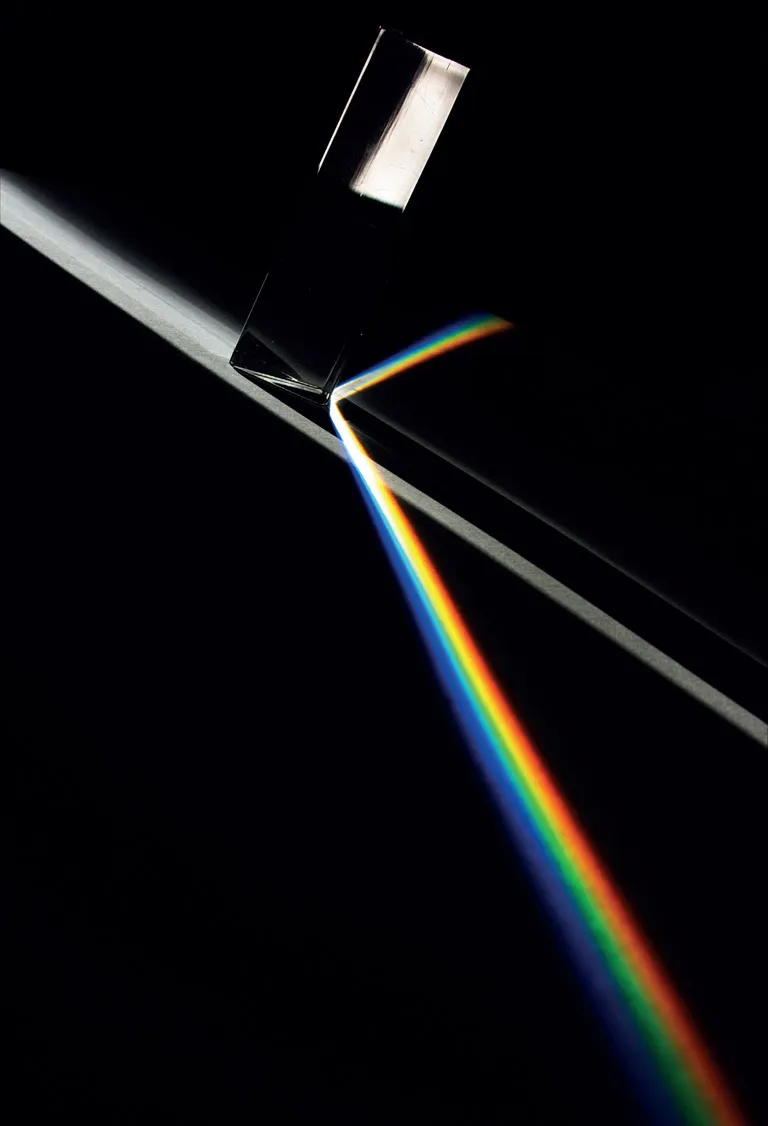
Prism (above)
White light split into its constituent spectrum by a prism of glass.
Photographer: Darren Pullman.
Technical summary: Canon EOS 400D Canon EF 28–135mm f/3.5–5.6 IS USM at 28mm (45mm 35mm equivalent) 1/30 at f/9 ISO 800.
White light split into its constituent spectrum by a prism of glass.
Photographer: Darren Pullman.
Technical summary: Canon EOS 400D Canon EF 28–135mm f/3.5–5.6 IS USM at 28mm (45mm 35mm equivalent) 1/30 at f/9 ISO 800.
Light is the narrow band of electromagnetic radiation to which the human eye is sensitive. There are no precise boundaries to the range of visible light, as individuals differ. Typically, our eyes are receptive to a range of wavelengths of light between 400 and 700 nanometres (nm). (A nanometre is one millionth of a millimetre.)
Light has three physical properties that interest the photographer – amplitude (or intensity), its wavelength or frequency and the angle of vibration (or polarization). In layman’s terms, intensity can be thought of as the brightness, while the wavelength or frequency determines its colour; we can barely perceive changes in polarization but this phenomenon can be manipulated photographically with polarizing filters. These are covered in a later section.
Light travels in straight lines, which is why we get shadows. Light can also be bent (refracted), which means we can design lenses to focus images. It is also reflected off a mirror or silvered surface at the reverse angle to which it falls, like a billiard ball hitting a cushion. Knowledge of these simple facts allows photographers to shape light using cutters and reflectors.
Without light, there are no colours. A green pepper only looks green if the corresponding wavelengths (colours) are present in the illuminating light. In orange light that contains no green, a green pepper looks grey and colourless.
We have a definition of the light that contains all the colours and is therefore white – ‘daylight’ – but photographers use this term in a precise way and it is not quite what you might think. All our ‘white’ light comes from radiating energy sources – the sun, metal filaments heated by electric current (light bulbs), the light burst from an electric arc (flashgun). There is some implied connection with heat. Photographers use the idea of colour temperature – a spectrum derived from looking at the colours of objects as they heat up – to describe the precise colour of a light source, be it blue-white or yellow-white. Understanding colour temperature and how to control or adjust it is vital to film and digital camera work; the topic is discussed later.
‘Light is our paintbrush and it is a most willing tool in the hands of the one who studies it with sufficient care.’
Laura Gilpin (American landscape photographer)
Basic theory
Electromagnetic spectrum
We are familiar with the range of colours within the spectrum that exists between 400 and 700nm as the colours of the rainbow (red, orange, yellow, green, blue and violet – modern science no longer counts indigo as a usefully separate colour). You see the colours of the rainbow when a beam of light cuts through the edge of a drinking glass. This is exactly what happens in the controlled conditions of the physics laboratory using a prism of glass to create the coloured bands of the spectrum by bending (refracting) white light. The rainbow colours are spread out because different wavelengths (colours) of light move at different speeds through the denser glass. This simple observation is vital to accurate lens design as it is the source of colour fringes in images from less than perfect lenses. We need to understand the spectrum to know how to use filters.
The electromagnetic spectrum
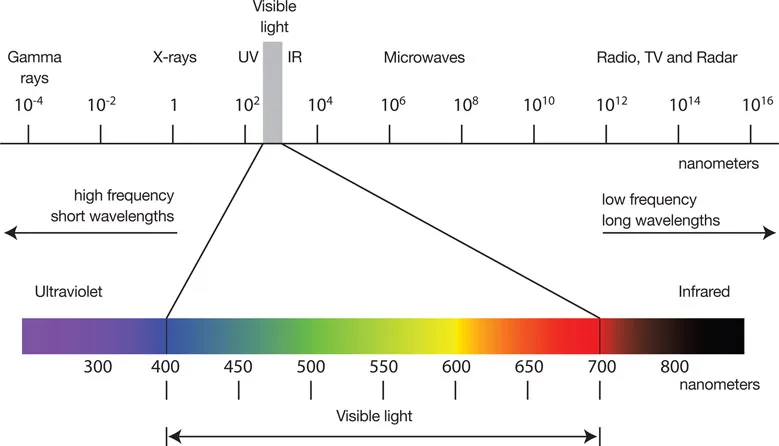
filter Glass or plastic device that modifies light passing through the camera lens. Computer software module that applies an image effect.
white light Equal blend of all colours in visible spectrum.
Inverse square law

The inverse square law
The inverse square law states that the intensity of light observed from a constant source falls off as the square of the distance from the source. Any light source that spreads its light in all directions obeys this law. In the real world, this is why it gets dark so quickly as you move away from the campfire!
Put simply, the inverse square law means that as you double the distance from the light, you quarter the light intensity. In fact, the light falls off as 1 over (inverse) the distance multiplied by itself (squared). The light measured at 2 metres from a light source will be 1/22 or 1/4 the intensity at 1 metre. The light measured at 4 metres from the same source will be 1/42 or 1/16th the intensity at 1 metre.
Photographically speaking, as every stop means a halving or doubling of light, 1/4 the amount of light is 2 stops down; 1/16th of the light is 4 stops down. Therefore, a light meter reading f/16 at 1 metre, for example, would read f/8 at 2 metres and would read f/4 at 4 metres.
It is important to understand this law, as it is one of the main ways in which light intensity can be controlled in the studio. The only light source that does not obey this law is the sun – as any distance we move something on earth is trivial compared to the distance from the earth to the sun.
White light and primary colours
White light passing through a prism creates all the colours of the rainbow, but only three of these colours are necessary to make up all the others. These are called the additive primary colours – red, green and blue – familiar from the ‘RGB’ label applied to TVs, computer monitors and video. Equal quantities of red, green and blue light add together to make white.
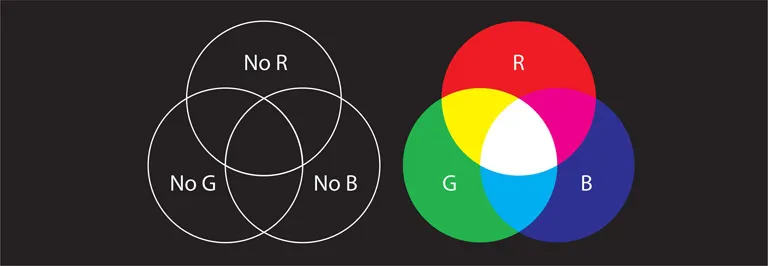
Additive colour mixing
Subtract any one of these colours – red, green or blue – from white light and you are left with a combination of the remaining primaries. The colours from the remaining combinations – cyan, magenta and yellow – are the so-called subtractive primaries.
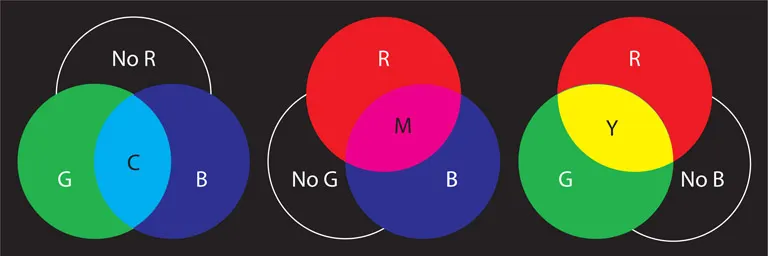
Subtractive primaries
RGB is the additive world of light and of the digital sensor; CMY is the world of reflected light, where these colours are used as dyes or pigments in our inks on white paper or as chemical dyes in film, to act as filters on white light to create the range of visible colours. Add equal quantities of cyan, magenta and yellow inks and you get black. Mix percentages of these inks and you can reproduce most colours; equal percentages always give a neutral grey. True black ink is added in four-colour (CMYK) printing, as real-world pigments are not pure enough to mix to black, instead giving a dirty purple-brown.
Subtractive colour mixing

Photographers’ colour wheel
Photographers find it useful to put the colours of the spectrum on a wheel, which helps in understanding how to filter and manipulate light. Red, green and blue will be found 120° apart on the wheel (at the twelve o’clock, four o’clock and eight o’clock positions). All other colours, as combinations of the three primaries, lie in between.
In colour correction, you use opposite colours on the wheel to cancel each other out. For instance, an image with a particular blue cast can be corrected by adding the yellow that lies opposite that blue on the colour wheel. A black-and-white photographer, wanting to darken the sky’s appearance, would choose a red filter opposite to the sky’s colour (cyan) on the wheel.
Digital camera users will often find hue (colour) adjustments described as a certain number of degrees. This represents a shift in colour around the colour wheel through an arc of that angle, rather like moving a few minutes round a clock face.
Adjustments to colour images in computer software make sense when you understand the colour wheel. Imagine a strip taken from round the edge of the wheel being used to show every...
Table of contents
- Cover
- Title Page
- Copyright Page
- Contents
- Introduction
- What is light?
- Natural light
- Available light
- Photographic light
- Controlling light
- Using light
- Conclusion
- Bibliography and webography
- Glossary
- Index
- Acknowledgements and credits
- Working with ethics